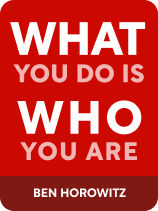

This article is an excerpt from the Shortform book guide to "What You Do Is Who You Are" by Ben Horowitz. Shortform has the world's best summaries and analyses of books you should be reading.
Like this article? Sign up for a free trial here .
How has the book What You Do Is Who You Are been received? What’s the book’s context and approach?
What You Do Is Who You Are, published in 2019 by HarperCollins Publishers, is an exploration of four unique historical models of leaders who designed successful cultures that supported their vision and strategy. Author Ben Horowitz extracts techniques that modern-day leaders can apply to their own culture-building.
Keep reading for a What You Do Is Who You Are review.
What You Do Is Who You Are Review
Ben Horowitz urges business leaders to take an intentional approach to designing and nurturing their organization’s culture. Because your culture is what you and your employees do, he argues that choosing and reinforcing the right beliefs and actions will allow employees to consistently behave in a way that aligns with what the company wants to be and achieve.
Our What You Do Is Who You Are review includes details on the book’s author, context, impact, reception, approach, and organization.
The Book’s Author
Ben Horowitz is an entrepreneur, investor, and bestselling author. He co-founded Opsware (formerly known as LoudCloud), which he then sold to Hewlett-Packard. He later co-founded a venture capital firm, Andreessen Horowitz, with partner Marc Andreessen. In addition to What You Do Is Who You Are, he is the author of The Hard Thing About Hard Things, about his experience and advice on starting a business.
Connect with Ben Horowitz:
The Book’s Context
What You Do Is Who You Are came out in the midst of a boom of technology-based startups, a period of strong interest in the role of startup founders as visionaries and leaders of both the company and its culture.
Horowitz’s book belongs to the fairly new field of organizational culture. Business leaders and academics began studying culture in the context of specific organizations in the 1950s with a focus on industrial productivity. But it wasn’t until the 1970s that they began to study organizational culture more holistically, with an understanding that it had a significant impact on the overall success of companies and the well-being of their employees.
Within this field, What You Do Is Who You Are is part of a particularly popular category of books written by business leaders themselves rather than scholars of organizational culture. This category includes books such as Leaders Eat Last (Simon Sinek, 2014), Delivering Happiness (Tony Hsieh, 2010), and No Rules Rules (Reed Hastings and Erin Meyer, 2020).
Horowitz’s book stands out in this category because it melds his own experiences as an entrepreneur and investor, the experiences of other business leaders he is close to, and four historical models of leadership from outside the business world. He also goes beyond describing successful cultures by prescribing steps to take and elements to consider when building your own culture.
The Book’s Impact and Critical Reception
Although the book received mostly positive reviews, in terms of copies sold it was not as successful as Horowitz’s first book, The Hard Thing About Hard Things, which landed on the New York Times best-seller list and is still one of the most sought-after books for entrepreneurs.
Reviewers who enjoyed the book appreciate Horowitz’s writing style, his use of real-life anecdotes and unusual historical examples, as well as the fact that he acknowledges there is no recipe for an ideal culture.
Critics point out that his use of the historical models, in particular Toussaint Louverture’s story, does not consider the broader context of the time or whether the lessons he extracts truly represent those leaders’ legacies. Specifically, readers question the usefulness of war as a metaphor for business, Horowitz’s apparent misunderstanding of slave culture, and what they view as simplistic comparisons of complex historical eras to corporate culture.
The Book’s Approach
The book argues that intentionally designed, sustainable cultures are a key ingredient of successful organizations. Horowitz offers techniques that leaders can apply to create and nurture intentional cultures, and he pulls examples from history as well as modern-day businesses to support his arguments.
The Book’s Organization
The book is divided into 10 chapters and begins by discussing four historical examples of intentional cultures along with modern-day examples that apply some of their principles. Horowitz then explains how to think about your own personality and your company’s strategy to understand what kind of culture you need to create. He discusses specific situations where culture might be especially challenging, and he identifies elements he thinks every culture should have. Finally, he suggests a checklist of principles.
Throughout the book, Horowitz defines culture in a few different ways, recalls personal anecdotes and stories of business leaders he knows, and even includes a few sections where other leaders speak in the first person, as though they were telling their stories themselves. In all, this makes the book engaging to read, but blurs the focus, so it may be hard for readers to extract the key takeaways they can apply to their own organizations.

———End of Preview———
Like what you just read? Read the rest of the world's best book summary and analysis of Ben Horowitz's "What You Do Is Who You Are" at Shortform .
Here's what you'll find in our full What You Do Is Who You Are summary :
- The three reasons leaders should care about culture
- How a sense of purpose boosts employees' performance
- What the Samurai and Genghis Khan can teach you about leadership






